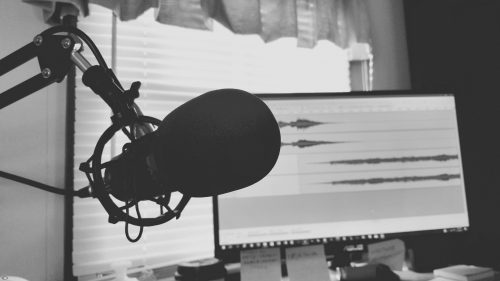Ever completed your emotional prep, line memorization, framing set up, rehearsal, and finally recorded your self-taped audition just to realize that you sound like you are in an echoey room or that the hum of the computer was louder than your own voice? UGH! Been there! It’s so incredibly frustrating to pretty much know your hard work will be overshadowed by the lack of audio. My microphone had ruined my self-taped audition.
Once this happened to me, I set out to find a better aftermarket microphone. But that ended with microphones being sent back. Sigh. Then I realized I had listened to podcasts and YouTube videos of professional actors talking about their equipment! I didn’t need to reinvent this wheel. I needed to figure out which of these worked best for me with my budget and space. No worries for you though! I’ve pulled all this information into a neat article for you to explore. Check out my list of Best Microphones for Self-Taped Auditions.
Microphone Buying Guide
First, step is a quick review of what microphones there are in the world and why I recommend a Condenser microphone for SE Self-Taped Auditions.
3 Primary Types of Microphones
Dynamic Microphones are an amazing microphone for live performance and/or very loud sources. They have the best resistance to feedback, can handle greater volumes than other mics, and interestingly don’t require a power source. However, since self-taped auditions rarely (or never) require drum solos, it’s not the optimum choice for our need.
Ribbon Microphones, which get their name from internal foil that looks like a ribbon, were the popular choice back in the 1940s and 1950s. they are only bi-directional, which makes them ideal for overhead listening, such as for an orchestra. Though these microphones produce a wonderful vintage sound, they are not best the bi-directional capability is not ideal for focusing the attention on just you.
Condenser Microphones have the sensitivity and the flexibility in their various designs to be the model type of Microphone for Self-Taped Auditions. These mics ten to be more sensitive, picking up more details, and allowing for an emotive performance to be fully captured. They typically capture a wider range of frequencies permitting for a wider range of the actor. Condensers can be omnidirectional; however, for our needs, it is best to focus on shotgun or unidirectional microphones.
Microphone Mounting Type
In reviewing the various blogs, posts, and YouTube videos, there are two favored methods for mounting a microphone: to yourself with a lavalier or to your camera with shock mount or shoe mount (On-Camera). There are other methods of mounting, however, for the simplicity needed when setting up a self-taped audition. These are the best two for the job.
Of course, there are pros and cons to each. While both are great at capturing the closest source loud and clear, lavaliers allow for more movement (literal walking around). However, lavaliers are typically omnidirectional, so they are highly capable of picking up background or rustling clothes. So be careful with your set up. On Camera, on the other hand, need to be relatively close to sound source, but this is works for Self-Taped auditions. Because they are directional, they are more precise with their capture, rejecting background and unwanted sounds.
And that is why this article focuses on On-Camera Directional Shotgun Microphones. Additionally, this type of microphone was more prominent and higher rated in the reviews and research. If you need a lavalier, check out our recommendations here: Microphones for Self-Taped Auditions – Lavaliers.
On-Camera Comparison Table
Check out my consolidated list of suggested Microphones for Self-Taped Auditions.
Rode Video MicPro Compact (VMPR) | Shure MV88 (MV88/A) | Deity V-Mic D3 Pro | TAKSTAR SGC-598 (SG_B07JL7GPHB_US) | Deity Microphones V-Mic D4 Duo (664767642) | Rode VideoMicro Compact (Videomicro) | Comica CVM-VM20 (CVM-VM20) | BOYA by-DMR7 (BY-DMR7) | Movo VXR10 Universal (VXR10) | |
Signal Noise Ratio | ~80dB | "exceptional" | 84dB | 79dBA | >75dB | 76dB | |||
Frequency Response Ranges | 40Hz - 20kHz | 20Hz - 20kHz | 50Hz - 20kHz | 50Hz -16kHZ | 50Hz-20KHz | 100Hz - 20kHz | 20Hz - 20kHz | 35Hz - 18 kHz | |
Self-Noise | 14db | 15dBA | "low" | "low" | |||||
Sensitivity | -32dB | -37dB | -24dB | -32dB | Front -42±3dB | -33dB | -43dB | -42dB | |
Compatibility | Cameras & Camcorders | Apple Devices | Smartphones & Cameras | Cameras & Camcorders | Smartphones & Cameras | Smartphones & Cameras | Smartphones & Cameras | Smartphones & Cameras | Smartphones & Cameras |
Mount | Rycote Shock | Lightning | Rycote Shock | Rycote Shock | Rycote Shock | Rycote Shock | Shockmount with Shoe-Mount | Shockmount | |
Output Connector | 3.5mm | Lightning | 3.5mm | 3.5mm | 3.5mm | 3.5mm | 3.5mm | 3.5mm | 3.5mm |
Battery Type | 9V (1) | A (1) | 320mAh Lithium Ion | 1.5V AA Alkaline | None Needed | None Needed | Lithium Polymer (1) | AA (2) | None Needed |
Warranty | 1-Year +10 w registration | 2-Years | 2-Years + 6 Months | None listed on Amazon or Takstar website | 2-Years | 1-Year +2 w registration | None listed on Amazon or Comica website | None listed on Amazon or Boya's website | 1-Year |
Recommended by Actor | |||||||||
Conclusion
So, that’s my consolidated list of Microphones for Self-Taped Auditions – On Camera. I personally will be using a Rode’s brand microphone. By far, this brand came up the most in the videos and suggestions Also, the Shure MV88 was listed on many articles and sites, such as Backstage & Willem Butler. However, budgets and spaces vary and there are many excellent options for your varying needs. I included other recommended microphones that are supportive of all budgets.











